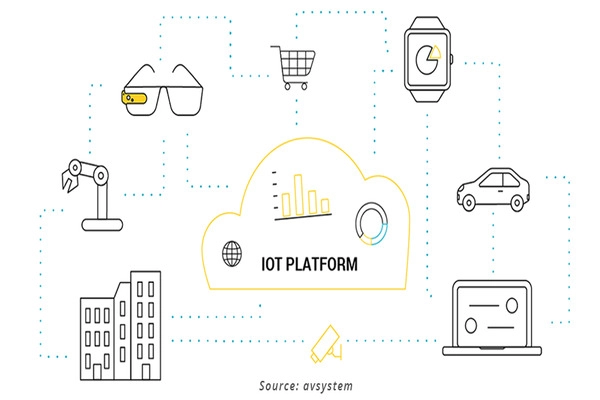IoT Platform is becoming a core foundation in the era of smart devices, enabling businesses to efficiently connect, manage, and analyze data from millions of devices. With flexible integration, powerful processing capabilities, and scalable support, IoT Platforms provide comprehensive solutions for all modern IoT systems, from smart homes to Industry 4.0.
What is an IoT Platform?
IoT Platforms are increasingly an essential part of the modern technology ecosystem. With the rapid growth of smart devices, the need for seamless connectivity, data collection, and operational management has become more complex. IoT Platforms act as a ‘central brain,’ allowing businesses to monitor, analyze, and control millions of devices in a synchronized manner.

Before diving deeper into its components and operation, it is important to understand that an IoT Platform is not just device management software; it is a comprehensive ecosystem that includes devices, connectivity, data processing, and value-added services.
Key Components of an IoT Platform
A complete IoT Platform consists of multiple layers, from hardware to software. Each component plays a distinct role but works closely together to ensure seamless data processing across the entire system. Here are the four most important components of a modern IoT Platform:
IoT Devices
IoT devices are the foundational hardware of the system. They can include sensors, cameras, smartwatches, energy meters, industrial equipment, or machinery in production lines. These devices collect data from the environment—such as temperature, humidity, location, speed, or motion—and transmit it to the central system.
IoT Gateway
The IoT Gateway acts as a bridge between devices and the cloud system. Instead of each device connecting directly to the server, the gateway aggregates data, performs preliminary processing, and ensures stable transmission. It also supports different network protocols such as MQTT, CoAP, Modbus, HTTP, allowing the system to operate smoothly and flexibly.
Cloud Computing
Cloud computing provides the infrastructure to process, store, and analyze massive amounts of data in an IoT Platform. The cloud allows flexible scalability to handle continuously changing data from millions of devices. With cloud processing power, businesses can implement data analytics, AI, or Machine Learning algorithms to generate valuable insights.
IoT Platform Services and Software
This is the central software layer where all data is collected, visualized, and managed. Services typically include device management, security, API integration, data analytics tools, and dashboards. This layer allows users to monitor device operations, configure the system, manage users, and receive alerts in case of issues.
How an IoT Platform Works
To understand how an IoT Platform operates, imagine data flowing through each step like a continuous stream:

- IoT Devices collect data from the environment, such as temperature, location, and light.
- IoT Gateways receive this data and perform preliminary processing, ensuring the information is stable and consistent.
- The data is then transmitted to the cloud, where the IoT Platform handles critical tasks such as processing, storage, and analysis.
- The results are displayed on a dashboard, allowing users to easily monitor the system’s status.
- Users can receive alerts and control devices remotely in real-time, with minimal manual intervention.
Popular Types of IoT Platforms
To meet diverse business needs, IoT Platforms are categorized into different types, each serving a specific purpose:
- Device Management Platform: Manages devices, updates firmware, and monitors performance.
- Connectivity Platform: Manages network connections, ensuring stable data transmission from IoT devices.
- Application Enablement Platform (AEP): Provides tools for businesses to build custom IoT applications.
Some of the most popular platforms today include AWS IoT, Google Cloud IoT, Microsoft Azure IoT, Siemens MindSphere, and Huawei IoT Platform.
Benefits of Using an IoT Platform
In the digital era, an IoT Platform serves as a “powerful assistant” that helps businesses efficiently manage smart devices and leverage data. Key benefits include:

- Centralized Device Management: Easily monitor thousands of IoT devices from a single platform.
- Real-Time Monitoring: Quickly detect issues and support precise maintenance.
- Operational Optimization: Deep data analysis helps predict risks and improve process efficiency.
- Cost Savings: Reduce manual labor through intelligent automation.
- Scalable System Expansion: Flexibly upgrade as the business grows and the number of devices increases.
Challenges in Implementing an IoT Platform
Although IoT Platforms offer many benefits, they also face several significant challenges:
- Data Security: IoT systems store sensitive information and are always at risk of cyberattacks.
- Diverse Device Integration: Challenges arise when connecting devices from multiple manufacturers with different protocols.
- Initial Investment Costs: Small businesses may face budget constraints in deploying a comprehensive platform.
- Operation and Maintenance: Requires a skilled technical team, which not all organizations are prepared for.
Future Trends of IoT Platforms
Looking ahead, IoT Platforms promise groundbreaking innovations, creating opportunities for businesses to operate more intelligently:

- AI and Machine Learning Integration: Supports deep data analysis, trend prediction, and smarter decision-making.
- Edge Computing: Processes data directly on devices or gateways, reducing cloud load and speeding up response times.
- Open and Flexible: Supports multiple protocols and standards, enabling easy integration with other systems.
- Enhanced Security and Automation: Ensures data safety while minimizing manual intervention.
- Customizable for Business Needs: Allows platforms to scale and be personalized according to company size and objectives.
An IoT Platform is not just a device management tool – it is a strategic platform that helps businesses optimize operations and generate new value from data. Despite ongoing challenges in security and integration, the rapid development of AI, cloud, and edge computing will continue to drive IoT Platforms to become a key enabler of digital transformation in the future.
